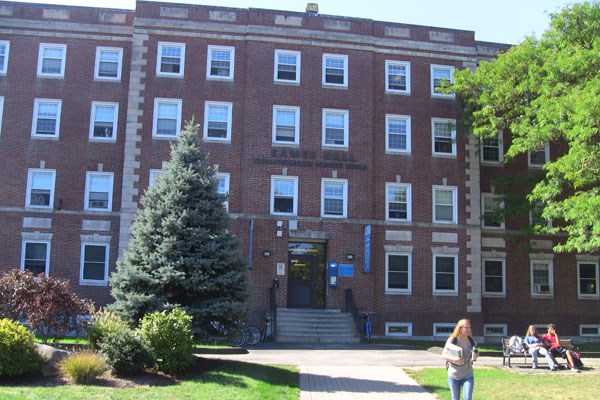After 67 Years, North Campus Dorm Giving Way to New Business School

03/15/2015
By Ed Brennen
Eames Hall is about to meet the wrecking ball. Or, the hydraulic grapple, to be more accurate.
Demolition of the 67-year-old North Campus dormitory began March 16, during spring break, and will continue until May 6, clearing the way for construction of the $41.5 million Pulichino Tong Business Building.
According to Facilities Management Project Manager Bob Bradley, demolition will be done by hydraulic grapple, which eliminates the need for blasting. “It looks like a giant lobster claw,” Bradley says. “It will keep grabbing the structure and tearing it down.”
Once the structure and foundation are cleared, the site will require some controlled ledge blasting to make way for the new building’s foundation. Blasting is scheduled to begin one day after the May 16 Commencement and continue for three weeks.
“We’ll wait until the campus is empty,” says Bradley, who adds that nearby property owners have been notified of the demolition and blasting schedule. “Then we’ll have a month before summer semester begins.”
Eames Hall has stood on the corner of University Avenue and Riverside Street since 1948, when it opened as one of the first two dormitories for the Lowell Textile Institute. The five-floor, 28,000-square-foot brick building was named after Charles H. Eames, who led the Textile Institute for almost four decades. The 118-bed dorm has been home to thousands of students over the past seven decades, most recently as housing for the Honors College.
In 2011, Eames’ sister building, Smith Hall, was taken down to make way for the Mark and Elisia Saab Emerging Technologies and Innovation Center.
Eames is giving way to the new Pulichino Tong Building, which will be home to the Manning School of Business. The four-story, 54,000 square-foot building will include a specialized lab that can be used as a financial trading room, as well as 10 technology-enhanced classrooms and seminar rooms to accommodate more than 400 students.
The centerpiece of the Pulichino Tong Building will be a four-story atrium overlooking an outdoor plaza and green space along University Avenue. The building also will connect to Lydon Library, providing an open area for meetings and collaboration.
Along with the Saab Center and nearby academic and laboratory complex, the Pulichino Tong Building will be at the heart of the North Campus Innovation District, which brings the university’s engineering, science and business programs together for students, entrepreneurs and industry partners.
Despite this winter’s epic snowfall, the new building is on track to open in mid-spring 2017. Bradley says the next step of the project, which is being managed by the state’s Division of Capital Asset Management and Maintenance (DCAMM), will be getting more than a dozen plumbing, electrical, flooring and HVAC subcontractors on board this spring.
And, just as with Smith Hall, a time capsule has been found in the Eames cornerstone. The brass box has been extracted and will be opened during a ceremony at a later date.
The building will be named for alumni John Pulichino ’67 and his wife, Joy Tong ’14 (H), successful entrepreneurs in the travel-goods industry who have donated $4 million to student scholarships.
